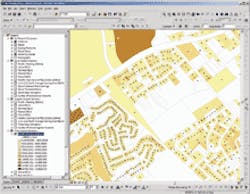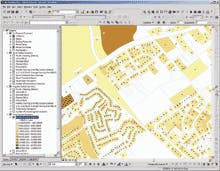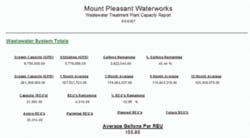Capacity Analysis System Tracks Utility’s Performance
by Tracee Gingrich
The buzz word is capacity. Municipal water and wastewater utilities across the nation have historically been concerned about demand versus supply and permits versus capacity – and rightly so. With stringent EPA regulations, NPDES permitting and state health department guidelines, knowledge of where the needle sits on the capacity meter is critical for further development, future revenue, and fiscal responsibility.
Traditional engineering calls for averaging wastewater flow based on land use and aggregate averaging within a drainage basin for capacity analysis. With the advent of Geographic Information Systems (GIS), analysis based on averages was more easily performed. But satisfaction with averages is waning as real-time technology is able to deliver more accurate, timely and precise data. GIS systems are becoming integrated with Customer Information Systems (CIS) to provide information that is accurate, up-to-date and yes, even virtual.
Staff at Mount Pleasant Waterworks (MPW) in South Carolina had a keen interest in knowing their daily wastewater flows in relation to permitted capacity. Future residential and commercial developments weighed in the balance. Based on aggregate averages, the system was nearing capacity limits. The engineering firm Arcadis had worked with MPW in the past as their preferred GIS vendor. MPW was currently using CIS Infinity, industry accounting software, and ESRI’s ArcGIS GIS Software Suite to increase their information capability. While these systems provided superior billing and accounting services, more information was now needed. The prevailing question: With two water treatment plants and 33,000 customers, was MPW exceeding permitted capacity?
Data link to reality
Using three known factors – customer addresses, water/wastewater infrastructure, and water/wastewater plants and basins – the solution was to geographically track water usage. Integrating three separate databases (GIS, CIS, and Project Tracker) was proposed, developed, installed and implemented. Taking data merger one step further, the CADD system was enveloped into GIS so that information regarding the system’s infrastructure was only a few clicks away. The MPW Wastewater Capacity Analysis System (WCAS) was born.
With an investment of $125,000 and six months time, the overall enterprise capabilities of MPW’s information systems were greatly expanded. Using GIS as the pivotal database link, customer address points were developed as GIS points. Every record in the GIS, CIS and Project Tracker databases were aligned to relate through the GIS system. Cross-validation checks highlighted inconsistencies and were flagged for correction. Developing the relationship between usage (residential or commercial) classification and actual water usage was a key element in functionality.
“We have helped MPW use GIS as a window to the other data systems that are tracking mission critical information. These integrations are continuously expanding their analytical capabilities into areas never before seen at a water and wastewater utility,” said David Ward, Arcadis Sr. GIS analyst and GISP.
Mouth Pleasant Wastewater plants were permitted for 9.1 mgd. Commercial properties were assigned an REU (residential equivalent units) based on the type of business. Residential units are assumed to use 300 gpd. During the data input stage, it was discovered that South Carolina’s Department of Health and Environmental Control’s REU records did not match those of MPW’s. Among other causes, there were parcels that had been permitted but had no usage.
Accurate information
Logically, the next question that demanded an answer: what are the actual gallons of water used per REU? Is it 300 as presumed? The solution was relatively simple. Calculate inflows to the sewer network and compare these values to the capacity of the wastewater treatment facilities of MPW. The new database was queried and the answer: 155.85 gpd. MPW has plenty of capacity in their system. That was welcome news.
The system continues to prove its worth as more value add-ons become obvious. Recently, MPW desired to improve the efficiency of the meter reading sequence. The WCAS plotted and platted the best sequence of neighborhood navigation – in just a matter of minutes. Need to know if any customers are exceeding allotted water usage? Using color-coding, these errant parcels are showcased in red. Want to inspect the system’s many miles of underground pipes? Using the CADD element, the infrastructure network is layered into the GIS screen. Click on a specific pipe and information regarding diameter, material, and installation dates will appear. As the need for replacement or repair of aging pipelines increases, the value of virtual infrastructure information can only escalate.
This CADD/GIS layering has also proven invaluable in targeting potential revenue by isolating septic system users. Being that Mount Pleasant is a coastal marsh area, septic systems give rise to environmental concerns. Using data from the WCAS, MPW is poised to deliver conservation messages and tactics (such as low-flow toilets and shower heads) to customers that routinely exceed usage allowances.
The WCAS allows for 1, 3, 6, and 12 month averages to display. The system summarizes treatment plant totals to give MPW engineers an accurate view of the current and future demands being placed on the water and wastewater systems.
“The WCAS solved an engineering need for us by providing instant access to water usage data at the customer and treatment plant levels, allowing us to closely monitor capacity as usage increased,” said Peter Fennell, Mt. Pleasant Waterworks engineer.
Real-time, on-time
Arcadis developed a unique and innovative system to represent near real-time utilization throughout the water and wastewater system. The WCAS project showcased the interplay between CIS and GIS. The engineering firm integrated existing information sources and leveraged the power of GIS to summarize and analyze usage information for quick and easy access by MPW. Mount Pleasant staff now has full access to a collection of routines, processes, and scripts that assist MPW in the visualization of water and wastewater utilization and capacity.
Arcadis took averages out of answers, reconciled data and created a state-of-the-art integrated database to deliver real-time information to MPW. In this age of information technology where instant access to answers is the norm, it should come as no surprise that the water and wastewater industry welcomes virtual capability. It’s smart management. It’s now and it’s the future.
About the Author: Tracee Gingrich writes for Arcadis from its corporate offices in Highlands Ranch, CO. She can be reached at [email protected]. Contributing editor: David Ward, GISP.


